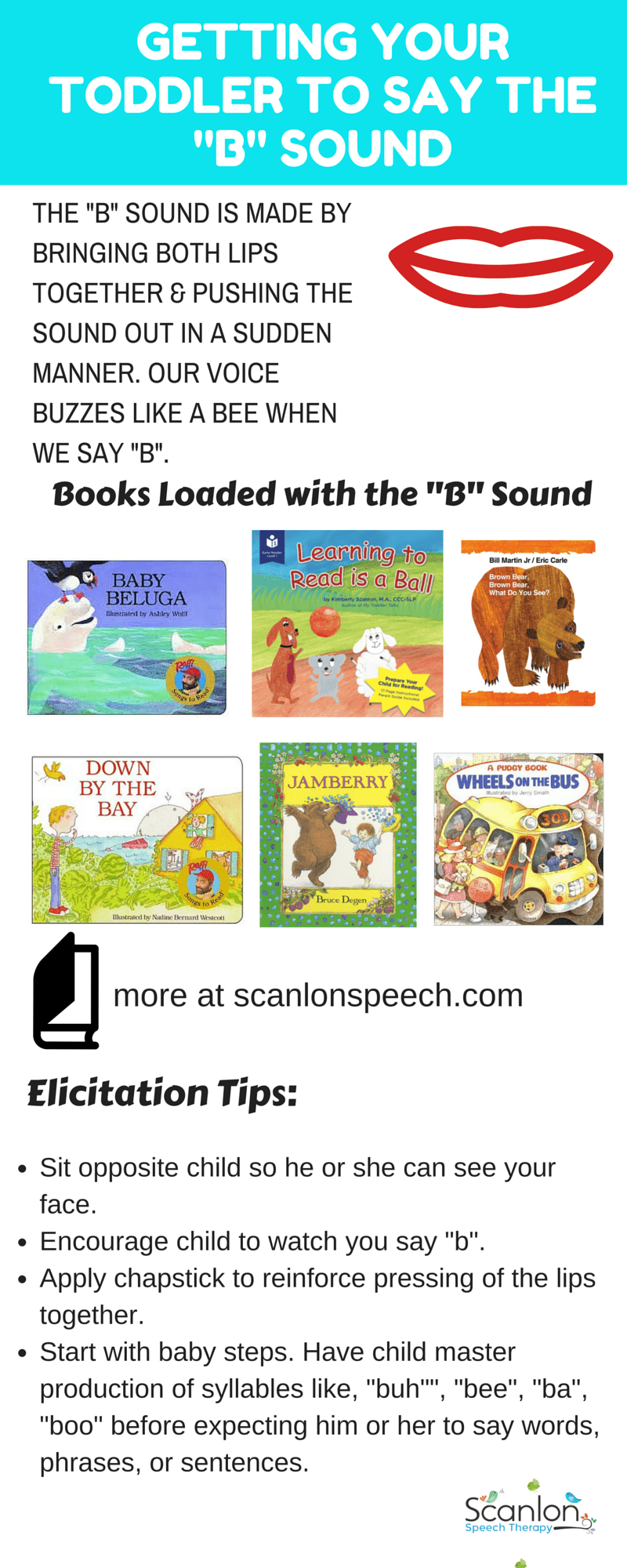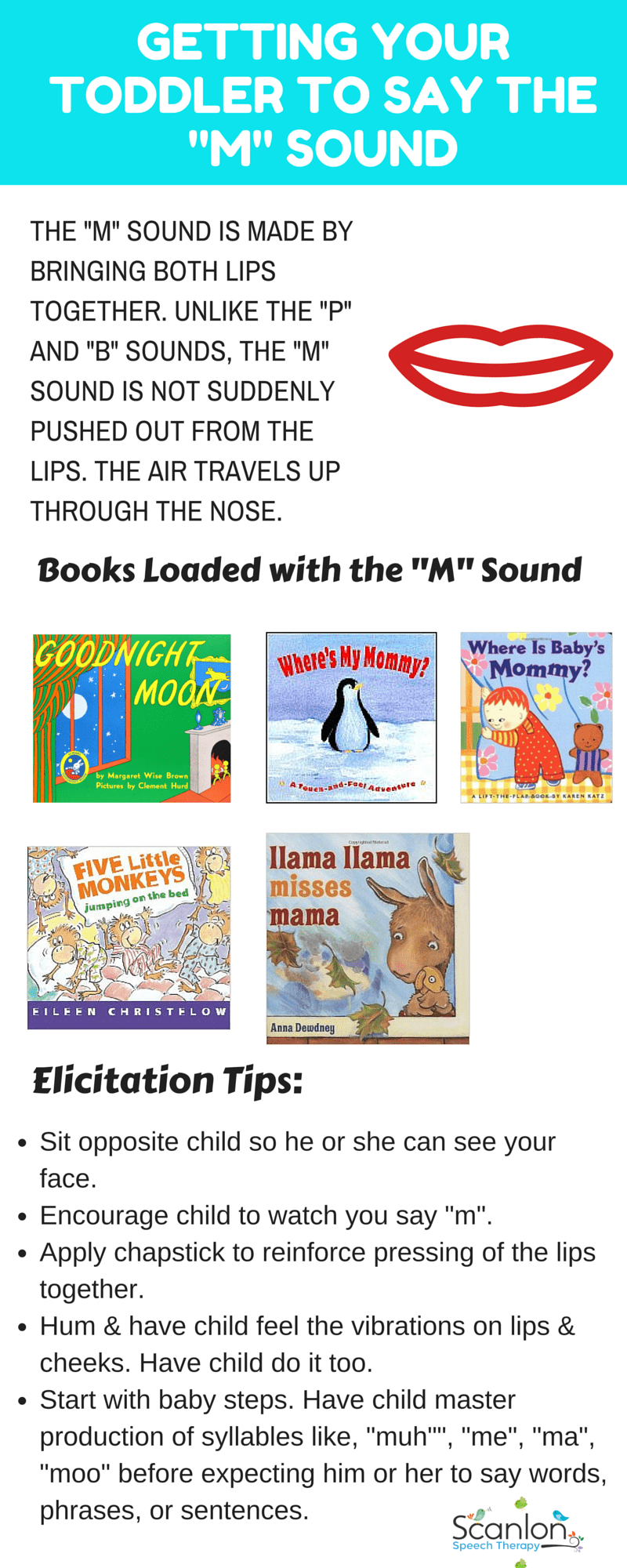Sign Up For Our E-Blast To Receive Information on our Books, Speech Therapy materials and our latest freebies!
Getting Your Toddler to Say the “P”, “B” and “M” Sounds
Children’s articulation or the ability to say speech sounds, require some time and practice to mature and improve. As explained in My Toddler’s First Words, mispronunciations are common when children are learning to speak. As children’s vocabularies expand and they say more words and combine words together, their ability to speak more clearly usually improves too.
Ps, Bs, and Ms are early developing sounds that most children can typically pronounce correctly between the ages of 2 and 3 years old.
If your toddler has difficulty producing Ps, Bs, or Ms, otherwise known as bilabials, you’re probably wondering what you can do to help?
This blog post includes some helpful developmentally appropriate strategies to try as well as book recommendations that are loaded with these sounds.
The “P” Sound
The “p” sound is made by bringing both lips together and pushing the sound out in a sudden manner. Speech therapists refer to the “p” sound as a voiceless plosive bilabial.
Before reading these books, I teach my clients how to say the “p” sound. I provide visual, tactile, and auditory support. We start at the sound level, then the syllable level, then the word level, then the phrase level. Complexity gradually increases depending on the child.
My visual placement articulation cards are VERY helpful to remind children/students/clients to keep their lips together to say the “p” sound. They are inexpensive and available for purchase in my teachers pay teachers store.
After my clients achieve some success keeping their lips together at the word level to say the “p” sound, we progress to reading books together. Being a skilled speech language pathologist, I properly scaffold and determine whether to have them imitate or try to spontaneously say a phrase or sentence with the target sound.
Here are some books that I like to use to practice the “p” sound (These are Amazon affiliate links and if you choose to to order through these links I receive a small commission that helps me manage this website. Thank you!):
Hop on Pop by Dr. Seuss
Peek-A Who? by Nina Laden
Peek-a-Moo! (Lift-the-flap Books) by Marie Torres Cimarusit
Pigs in Pajamas by Maggie Smith
This book should should also be on my list of favorite Alliteration Books but is not. Shall add in soon!
That’s Not My Puppy (Usborne Touchy-Feely Board Books)by Fiona Watt
Max’s Potty by Harriet Ziefert
The “B” Sound
The “b” sound is made by bringing both lips together and pushing the sound out in a sudden manner. The difference between the “p” and “b” sound is that we use voice when we say it. This means that our vocal folds vibrate and buzz like a bee 🙂 (Speech therapists refer to the “b” sound as a voiced plosive bilabial).
Before reading these books, I teach my clients how to say the “b” sound. I provide visual, tactile, and auditory support. We start at the sound level, then the syllable level, then the word level, then the phrase level. Complexity gradually increases depending on the child.
My visual placement articulation cards are VERY helpful to remind children/students/clients to keep their lips together to say the “b” sound. They are inexpensive and available for purchase in my teachers pay teachers store.
 After my clients achieve some success keeping their lips together at the word level to say the “b” sound, we progress to reading books together. Being a skilled speech language pathologist, I can then properly scaffold and determine whether to have them imitate or try to spontaneously say a phrase or sentence with the target sound. Reading books provides the context for the word to come to life!
After my clients achieve some success keeping their lips together at the word level to say the “b” sound, we progress to reading books together. Being a skilled speech language pathologist, I can then properly scaffold and determine whether to have them imitate or try to spontaneously say a phrase or sentence with the target sound. Reading books provides the context for the word to come to life!
Here are some books that I like to use to practice the “b” sound (These are Amazon affiliate links and if you choose to to order through these links I receive a small commission that helps me manage this website. Thank you!):
Baby Beluga (Raffi Songs to Read)
For more tips on how to use this book to promote your toddler’s language development, please read my post, Baby Beluga: A Book & Song to Improve Your Toddler’s Language.
Brown Bear, Brown Bear, What do You See by Bill Martin and Eric Carle
For more tips on how to use this book to develop your toddler’s language, please see my post:
How to Use Brown Bear, Brown Bear, What do you See to Get Your Toddler Talking.
Belly Button Book by Sandra Boynton
Down by the Bay by Nadine Bernard Westcott and Raffi
Jamberry by Bruce Degan
Learning to Read is a Ball by Kimberly Scanlon
This book is also included on my list of books, Rhyming Books that Will Make You Laugh.
Where Is Baby’s Belly Button? by Karen Katz
The Wheels on the Bus (A Glittery Nursery Rhyme Book) by Jenny Tulip
The “M” Sound
The “m” sound is also made by bringing both lips together BUT it’s not suddenly pushed out from our lips. There is a nasal component to it. The air travels up through our nose. So, the nose buzzes like a bee. Lips do too.
Before reading these books, I teach my clients how to say the “m” sound. I provide visual, tactile, and auditory support. We start at the sound level, then the syllable level, then the word level, then the phrase level. Complexity gradually increases depending on the child.
My visual placement articulation cards are VERY helpful to remind children/students/clients to keep their lips together to say the “m” sound. They are inexpensive and available for purchase in my teachers pay teachers store.

Five Little Monkeys Jumping on the Bed by Eileen Christelow
Goodnight Moon by Margaret Wise Brown
I have created a book companion for Goodnight Moon and also have a video on youtube demonstrating how I use this book with my children and clients!
Llama Llama Misses Mama by Anna Dewdney
Where is Baby’s Mommy?by Karen Katz
Where’s My Mommy? by Sarah Smith
Tips for Eliciting P, B, and M Sounds
- Sit directly opposite your child so he or she can see your face
- Encourage your child to watch you say /p, b, m/ by placing your fingers flat to your lips while you are saying the sounds (Speech therapists who are trained in PROMPT like myself, use different tactile prompting methods.)
- Start with baby steps. Have your child say and master production of syllables like, “pa”, “ba” or “ma” before expecting him or her to say words like pop, bob, or mop.
- Apply a small amount of flavored chapstick to reinforce pressing of the tips together
- Place a cotton ball or tissue on a flat surface and have your child watch you press your lips together and then release a burst of air to produce /p/ or /b/ as you make the item move across the surface. Encourage the child to do the same. This only works for the bilabials /p and b/. Note – you will see move movement with production of /p/ vs /b/. This is because /b/ is a voiced sound.
- Hum a little and have your child feel the vibrations on your lips and cheeks. Have your child do the same. This only works for bilabial /m/.
- If your child is still having difficulty with producing these sounds seek the expertise of an experienced speech language pathologist.
Kimberly Scanlon, M.A. CCC-SLP is a speech language pathologist, an author and a mother. As the owner of Scanlon Speech Therapy, LLC, a unique boutique practice in Bergen County, Kimberly embraces individuality and treats the whole person. Her goal is to spread compassion, hope, and some speech, language and literacy tips one moment, one person at a time. Her first book, My Toddler Talks: Strategies and Activities to Promote Your Child’s Language Development and her second book, Learning to Read is a Ball
are available for purchase at online at Amazon and Barnes and Noble.























